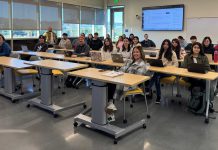GILROY
– Gilroy High School is climbing a mountain of improvement,
according to Principal Bob Bravo.
By Lori Stuenkel
GILROY – Gilroy High School is climbing a mountain of improvement, according to Principal Bob Bravo.
During a GHS progress report to the school board, Bravo acknowledged that the challenge will continue to require hard work on the part of many staff and students, but said he enthusiastically faces the task because the payoff will bring more pride to the GHS name.
“This idea of having value or having pride is one that resonates a lot, I think, with Gilroy High School and the staff,” Bravo said. “I think that that sense of building pride has led the staff and the students last year to some pretty good achievements toward statewide expectations on (standardized) testing. But we still have a way to go.”
Bravo and Assistant Principal Gregg Camacho-Light laid out for school board trustees last month the high school’s progress toward three “improvement initiatives” for the 2003-04 school year. The goals include developing a public and guaranteed curriculum, building a positive learning environment and continually improving teaching.
The initiatives, taken from research on schools that have made dramatic improvements, are an example of GHS’s dedication to using proven methods, Bravo said.
“The new kind of research, I think, that we have now is … research that takes a look at schools that out-perform other schools,” he said. “Schools that break the mold, schools where there’s lots of students who may be on free and reduced lunch or lots of students who may be still learning English, but nonetheless pass up other schools that don’t have those kinds of demographics.”
GHS has been working on curriculum maps for the English, social science, science and math departments since last spring. Curriculum maps, which align state standards to classroom lessons, became a districtwide priority nearly three years ago.
“It’s imperative in terms of providing continuity across the grade levels, throughout the district and across schools, that you have an alignment between what’s considered what the curriculum is that’s written, what the curriculum is that’s taught, what the curriculum is that’s tested,” said Jacki Horejs, assistant superintendent of educational services. “It really, I think, helped us bring a lot more aligned instructional program to the district, and it also brought to light to us the need to have materials aligned to the standards.”
At the time elementary and middle school curricula were mapped, Horejs said, no textbooks for high schools existed that were based on the California educational standards.
Now, Bravo said, the maps are nearly complete, pending a review process. They will be posted on the GHS Web site by Feb. 28.
“We believe in a guaranteed and visible public curriculum,” Camacho-Light said.
Mapping will continue this semester for physical education, vocational arts, foreign language and English language learners. The English department’s curriculum maps will remain a work in progress, because they will be revised after a textbook is selected this spring. Two different textbooks are being piloted this semester.
To fulfill their goal of creating a positive learning environment, GHS officials cracked down on tardies – being absent from class after the bell rings – this semester, reducing them by 64 percent compared to the same time in 2002.
Bravo attributed the successful reduction to a new citizenship grade policy adopted last spring, which restricts extracurricular activities after repeated unexcused tardies.
“The second initiative is really about everybody on campus honoring their responsibility,” he said.
Part of the staff’s responsibility is to maintain communication. Bravo said more teachers are using their e-mail accounts, and more frequently. All staff e-mail addresses are posted on the GHS Web site and more than 90 percent of staff are using their e-mail.
Staff development and continuous improvement of teaching are ongoing at GHS to fulfill its third initiative. All English, social science, science and P.E. teachers are trained in an intensive literacy program, while math teachers are training to use a performance-based test.
All GHS teachers are participating in training to use more writing in their classes.
Superintendent Edwin Diaz credited Bravo, teachers and staff for possessing an enormous amount of passion and commitment necessary for high-school reform.
“Improving student performance, engaging in school reform, district reform, is difficult, it’s messy and it doesn’t always appear to be a focused activity,” Diaz said. “When you look at high school reform, there’s less examples of high schools that have made the significant improvement, and I think … there’s a variety of reasons …
“There are so many things that come at the administrators, the staff members, the teachers, everyone on a daily basis and so your priorities can change quickly, and so what I want to acknowledge … is the ability of Bob and his staff to maintain the focus in an environment where it would be very easy to just react and go in a different direction.”
Some of GHS’s efforts can already be seen in its improved student performance, Diaz said.
The school improved its Academic Performance Index score, largely based on standardized tests, by 38 points last year, far surpassing the county average of a 15.3-point improvement. Over the last five years, GHS’s API has gone up 52 points, compared with a county average of 30.5.
Bravo said he has seen a newfound unity among staff since becoming principal in 2002, a goal of his from the start.
“When it came to doing the work of finding the common ground of what is everyone agreeing on, I really think that was it,” he said. “The common ground was a sense of pride that’s not based on good intentions but on actual, tangible achievements.”













